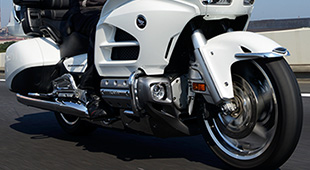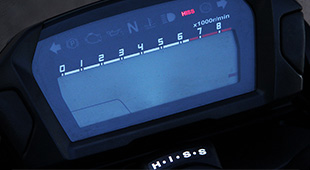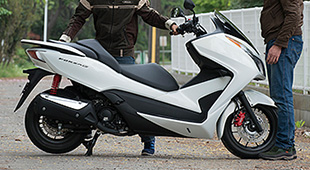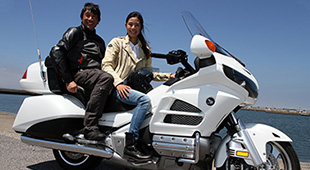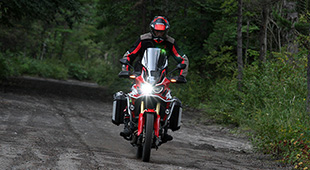Tech Views — Vol. 3 Mirrors
Detail (1/3)
Just being able to see correctly... That's where their value lies.
Are you aware of the major differences between mirrors?
The information we get from our mirrors -
When riding a motorcycle, this source of information is often just as important as the view ahead.
Like that 'view,' I think that a mirror's usability and range of adjustment also factor in among the many important performance features riders rely on.
Mirrors can be round, square, or other shapes, and mounted in many different ways, from handlebar-mounted types to those attached directly to a fairing or cowl. A wide range of types and styles are also available, but one truth remains: Easy-to-see mirrors make one's riding experience richer and more enjoyable.
Although some aftermarket mirrors might look cool or be designed with an emphasis on styling, mirrors that give an unsatisfactory view of what's behind are more stress-inducing than most people imagine. My feeling, based on many years of riding experience, is that riders should focus more on a mirror's degree of visibility than its physical appearance or how cool it looks.
So, what are the standards for this 'Degree of Visibility'?

Most countries have laws governing the safety aspects of vehicles using public roads. In Japan, for instance, many items related to motorcycle rearview mirrors, including mirror surface area, degree of visibility, adjustment ease, and collision safety, etc. are strictly regulated. Rules, of course, differ from country to country, but any motorcycle sold in an authorized dealership has met all such local legal requirements.
It therefore follows that every new bike from around the world that I've ever encountered complies with these standards. However, as noted earlier, depending on make and model, some mirrors are 'easy-to-see,' and others are not. I think this gives a clear understanding of a manufacturer's basic philosophy.
In this chapter, I've set out to reconfirm this important part of design philosophy.
In the City
Like most people, I use various forms of transportation to move comfortably through the city. In my early teens, I used to ride everywhere by bicycle. As someone who started riding motorcycles at the age of 17, I find the motorcycle's range of mobility and comfort to be its primary sources of enjoyment, and things that I can't compromise on.
Cities are populated by people of many ages who use many means of transport for innumerable reasons. People ride bicycles, drive cars, or walk as well. Cities have always been bustling societies of mixed movement. For this reason among many, good rearward visibility is often just as important as keeping a steady eye on the road ahead. Even when changing lanes to keep a safe distance from pedestrians, the rearward visibility of the mirrors plays a crucial part in allowing me to instantly make my decision to move.
It's interesting that at first glance mirrors all look pretty much the same. However, the degree of visibility they provide can differ greatly from vehicle to vehicle. What's the situation with, for instance, a scooter made to get around the city, like the Honda PCX with its relaxed riding position? The PCX's mirrors provide an ample visual field, and when on the move their clear visibility is almost completely unaffected by vibration. Critical visual information is there at a glance, from edge to edge across both mirrors, and the images reflected provide a good sense of the distance to following vehicles. I was especially pleased by how easy they were to adjust, and my level of satisfaction with these mirrors was high in all respects.
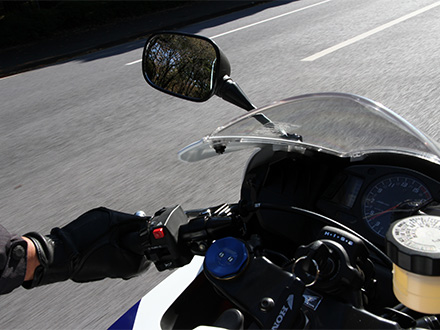
The PCX also delivers up an impressive degree of luxurious riding comfort for a 125cc class scooter, and seats two easily. I cruised the streets in the vicinity of my home with one of my family riding on back. This precious bit of time together brought smiles to both our faces. Even then, the wide range of clear visibility offered by the PCX's mirrors enabled me to enjoy this comfortable ride with complete peace-of-mind. Also, when carrying passengers, it certainly doesn't hurt to be able to see their faces, and really all mirrors should do this.
The SH Mode is another lively scooter for getting around town, and I could feel my back straighten up whenever I climbed aboard. From this upright posture, I felt like I was looking down a bit toward the mirrors. However my arms never came into reflected view, even when leaning close to the mirrors. Their degree of visibility was exactly what I expected. Just a quick glance was enough to let me see what I needed.
Also, because the mirrors were so close, it only took a slight turn of the head to widen the field of view and keep an eye on traffic conditions behind and around me. The degree of visibility these mirrors offered was crisp and clear, and remarkably good.
Honda has a long, proud history of making slim big-wheeled scooters with upright riding positions, going back to the SH50 first introduced on the streets of Europe in 1993. On other Italian-made models I've ridden, the mirror stays are often long, and while they're easy to see with when stopped, on the move their inherent vibration makes for viewing difficult. However, both the PCX and SH Mode were thankfully free from these problems.
I also tried out the 250cc-class Forza scooter and CRF250L dual-sport bike. The Forza's big scooter mirrors were virtually unaffected by vibration, and I could see no significant difference in distance perception between vehicles approaching from behind and their reflected images in the mirrors.
While checking these points, something occurred to me. While we motorcycle journalists readily note a bike's equipment, storage space and other features when writing our articles, we should really provide more feedback on the quality of the mirrors and their degree of visibility. One reason is that Honda's deep interest in achieving such a high degree of visibility in their mirrors seems extraordinary compared to other manufacturers.
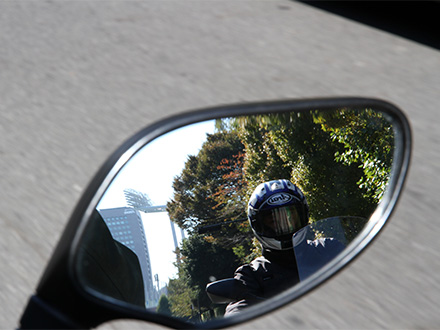
Dual-sport bikes like the CRF250L are often powered by single-cylinder engines, and in some cases the vibration felt in their steps, seat or tank can get to be quite an annoyance. In the case of single-cylinder models with relatively high handlebars, parts at the ends of the bars, such as grips and mirrors, can be especially susceptible to the effects of vibration and, paradoxically, these can be the best bikes to check for visibility. Although the CRF250L's mirrors are subject to the same sort of vibration, I didn't really notice it much from the standpoint of viewing ease. Even on a wide three-lane highway, I was able to accurately see what was both directly behind me and off to my sides.
On other makes of bikes, I've often noticed that the same mirrors are used year after year with no change in design. Although I understand that design in a matter of individual taste, I still think it might be best to occasionally update mirror designs in keeping with the times.
In terms of viewing ease, many such mirrors tend to force riders to move not only their eyes, but also their head, neck and more to get a clear view of changing conditions to the rear. Having to move one's body around to see what's behind shouldn't be necessary, and can be a bit unsettling. This also gives a clear indication that the mirrors are difficult to see with, and that their range of satisfaction is seriously lacking. With that perspective, my evaluation of the CRF250's mirrors confirmed that their level of performance was still quite high.
When I first began riding at the age of 17, I often replaced the original mirrors with other aftermarket brands that had what I thought were more attractive designs. I used to think of this as a first step toward customizing my bike, and didn't really give viewing ease much consideration. In other words, I often threw away the viewing ease that the original mirrors offered.
However, with more years of experience riding, I gradually came to learn that while keeping my eyes focused on the road ahead is an important premise of riding, seeking out places where I could really appreciate the grip of the tires on the road while taking in the vast space that surrounds me is also important.
Also, mirrors that simply look cool don't quite do the job. Instantly conveying critical visual information is the important job mirrors are assigned. Therefore, I've come to believe that we should all pay more attention to the mirrors we use and how the issues of visibility and viewing ease have been approached. As a rider, you've really got to be able to intuitively sense the difference. Based on my own experience, that's my advice.
- Top
- Detail
- User Reviews

